Bad Behaviour and Juvenile Delinquency Research Paper 2022
VerifiedAdded on 2022/10/17
|16
|3764
|16
AI Summary
Contribute Materials
Your contribution can guide someone’s learning journey. Share your
documents today.
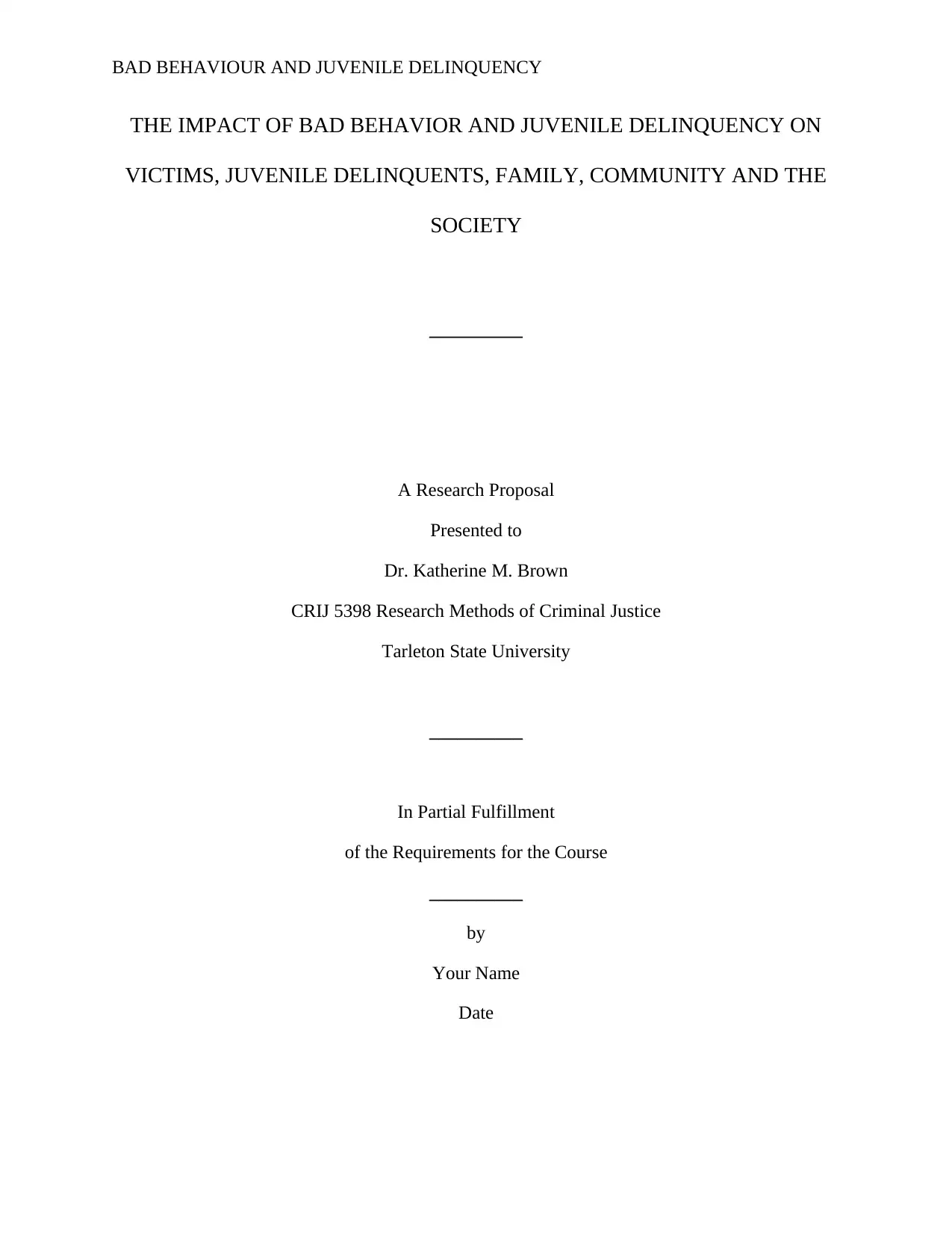
BAD BEHAVIOUR AND JUVENILE DELINQUENCY
THE IMPACT OF BAD BEHAVIOR AND JUVENILE DELINQUENCY ON
VICTIMS, JUVENILE DELINQUENTS, FAMILY, COMMUNITY AND THE
SOCIETY
__________
A Research Proposal
Presented to
Dr. Katherine M. Brown
CRIJ 5398 Research Methods of Criminal Justice
Tarleton State University
__________
In Partial Fulfillment
of the Requirements for the Course
__________
by
Your Name
Date
THE IMPACT OF BAD BEHAVIOR AND JUVENILE DELINQUENCY ON
VICTIMS, JUVENILE DELINQUENTS, FAMILY, COMMUNITY AND THE
SOCIETY
__________
A Research Proposal
Presented to
Dr. Katherine M. Brown
CRIJ 5398 Research Methods of Criminal Justice
Tarleton State University
__________
In Partial Fulfillment
of the Requirements for the Course
__________
by
Your Name
Date
Secure Best Marks with AI Grader
Need help grading? Try our AI Grader for instant feedback on your assignments.
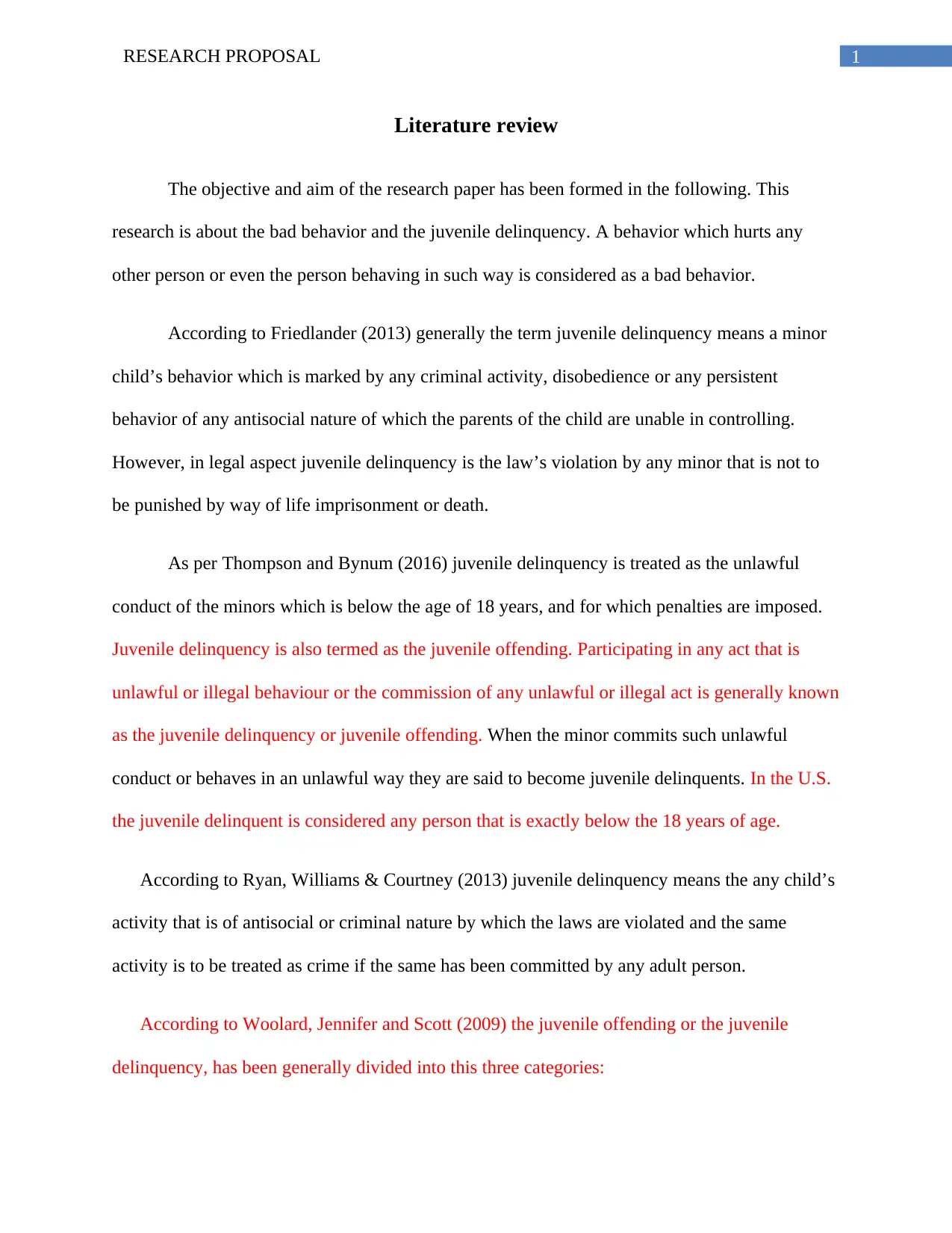
1RESEARCH PROPOSAL
Literature review
The objective and aim of the research paper has been formed in the following. This
research is about the bad behavior and the juvenile delinquency. A behavior which hurts any
other person or even the person behaving in such way is considered as a bad behavior.
According to Friedlander (2013) generally the term juvenile delinquency means a minor
child’s behavior which is marked by any criminal activity, disobedience or any persistent
behavior of any antisocial nature of which the parents of the child are unable in controlling.
However, in legal aspect juvenile delinquency is the law’s violation by any minor that is not to
be punished by way of life imprisonment or death.
As per Thompson and Bynum (2016) juvenile delinquency is treated as the unlawful
conduct of the minors which is below the age of 18 years, and for which penalties are imposed.
Juvenile delinquency is also termed as the juvenile offending. Participating in any act that is
unlawful or illegal behaviour or the commission of any unlawful or illegal act is generally known
as the juvenile delinquency or juvenile offending. When the minor commits such unlawful
conduct or behaves in an unlawful way they are said to become juvenile delinquents. In the U.S.
the juvenile delinquent is considered any person that is exactly below the 18 years of age.
According to Ryan, Williams & Courtney (2013) juvenile delinquency means the any child’s
activity that is of antisocial or criminal nature by which the laws are violated and the same
activity is to be treated as crime if the same has been committed by any adult person.
According to Woolard, Jennifer and Scott (2009) the juvenile offending or the juvenile
delinquency, has been generally divided into this three categories:
Literature review
The objective and aim of the research paper has been formed in the following. This
research is about the bad behavior and the juvenile delinquency. A behavior which hurts any
other person or even the person behaving in such way is considered as a bad behavior.
According to Friedlander (2013) generally the term juvenile delinquency means a minor
child’s behavior which is marked by any criminal activity, disobedience or any persistent
behavior of any antisocial nature of which the parents of the child are unable in controlling.
However, in legal aspect juvenile delinquency is the law’s violation by any minor that is not to
be punished by way of life imprisonment or death.
As per Thompson and Bynum (2016) juvenile delinquency is treated as the unlawful
conduct of the minors which is below the age of 18 years, and for which penalties are imposed.
Juvenile delinquency is also termed as the juvenile offending. Participating in any act that is
unlawful or illegal behaviour or the commission of any unlawful or illegal act is generally known
as the juvenile delinquency or juvenile offending. When the minor commits such unlawful
conduct or behaves in an unlawful way they are said to become juvenile delinquents. In the U.S.
the juvenile delinquent is considered any person that is exactly below the 18 years of age.
According to Ryan, Williams & Courtney (2013) juvenile delinquency means the any child’s
activity that is of antisocial or criminal nature by which the laws are violated and the same
activity is to be treated as crime if the same has been committed by any adult person.
According to Woolard, Jennifer and Scott (2009) the juvenile offending or the juvenile
delinquency, has been generally divided into this three categories:
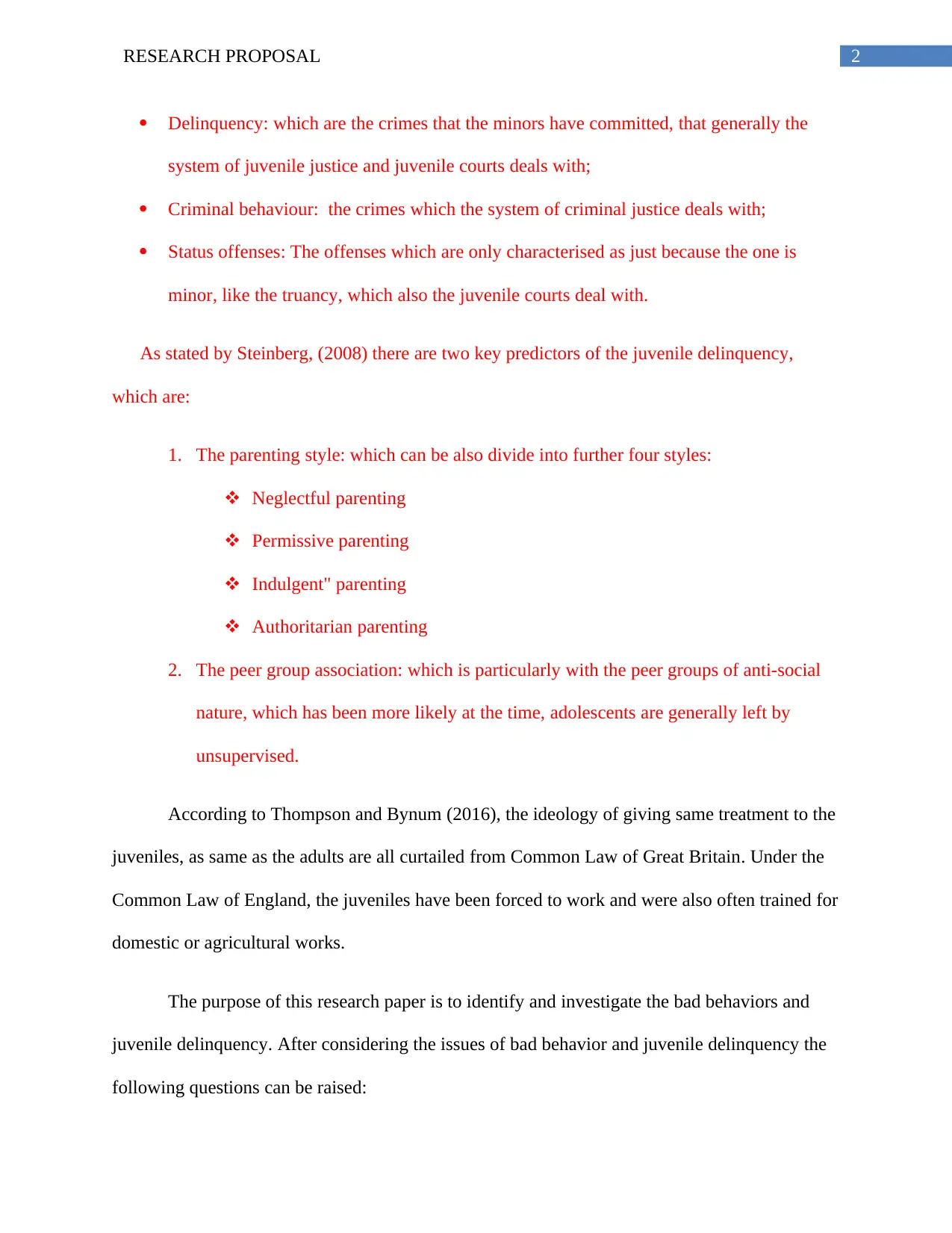
2RESEARCH PROPOSAL
Delinquency: which are the crimes that the minors have committed, that generally the
system of juvenile justice and juvenile courts deals with;
Criminal behaviour: the crimes which the system of criminal justice deals with;
Status offenses: The offenses which are only characterised as just because the one is
minor, like the truancy, which also the juvenile courts deal with.
As stated by Steinberg, (2008) there are two key predictors of the juvenile delinquency,
which are:
1. The parenting style: which can be also divide into further four styles:
Neglectful parenting
Permissive parenting
Indulgent" parenting
Authoritarian parenting
2. The peer group association: which is particularly with the peer groups of anti-social
nature, which has been more likely at the time, adolescents are generally left by
unsupervised.
According to Thompson and Bynum (2016), the ideology of giving same treatment to the
juveniles, as same as the adults are all curtailed from Common Law of Great Britain. Under the
Common Law of England, the juveniles have been forced to work and were also often trained for
domestic or agricultural works.
The purpose of this research paper is to identify and investigate the bad behaviors and
juvenile delinquency. After considering the issues of bad behavior and juvenile delinquency the
following questions can be raised:
Delinquency: which are the crimes that the minors have committed, that generally the
system of juvenile justice and juvenile courts deals with;
Criminal behaviour: the crimes which the system of criminal justice deals with;
Status offenses: The offenses which are only characterised as just because the one is
minor, like the truancy, which also the juvenile courts deal with.
As stated by Steinberg, (2008) there are two key predictors of the juvenile delinquency,
which are:
1. The parenting style: which can be also divide into further four styles:
Neglectful parenting
Permissive parenting
Indulgent" parenting
Authoritarian parenting
2. The peer group association: which is particularly with the peer groups of anti-social
nature, which has been more likely at the time, adolescents are generally left by
unsupervised.
According to Thompson and Bynum (2016), the ideology of giving same treatment to the
juveniles, as same as the adults are all curtailed from Common Law of Great Britain. Under the
Common Law of England, the juveniles have been forced to work and were also often trained for
domestic or agricultural works.
The purpose of this research paper is to identify and investigate the bad behaviors and
juvenile delinquency. After considering the issues of bad behavior and juvenile delinquency the
following questions can be raised:
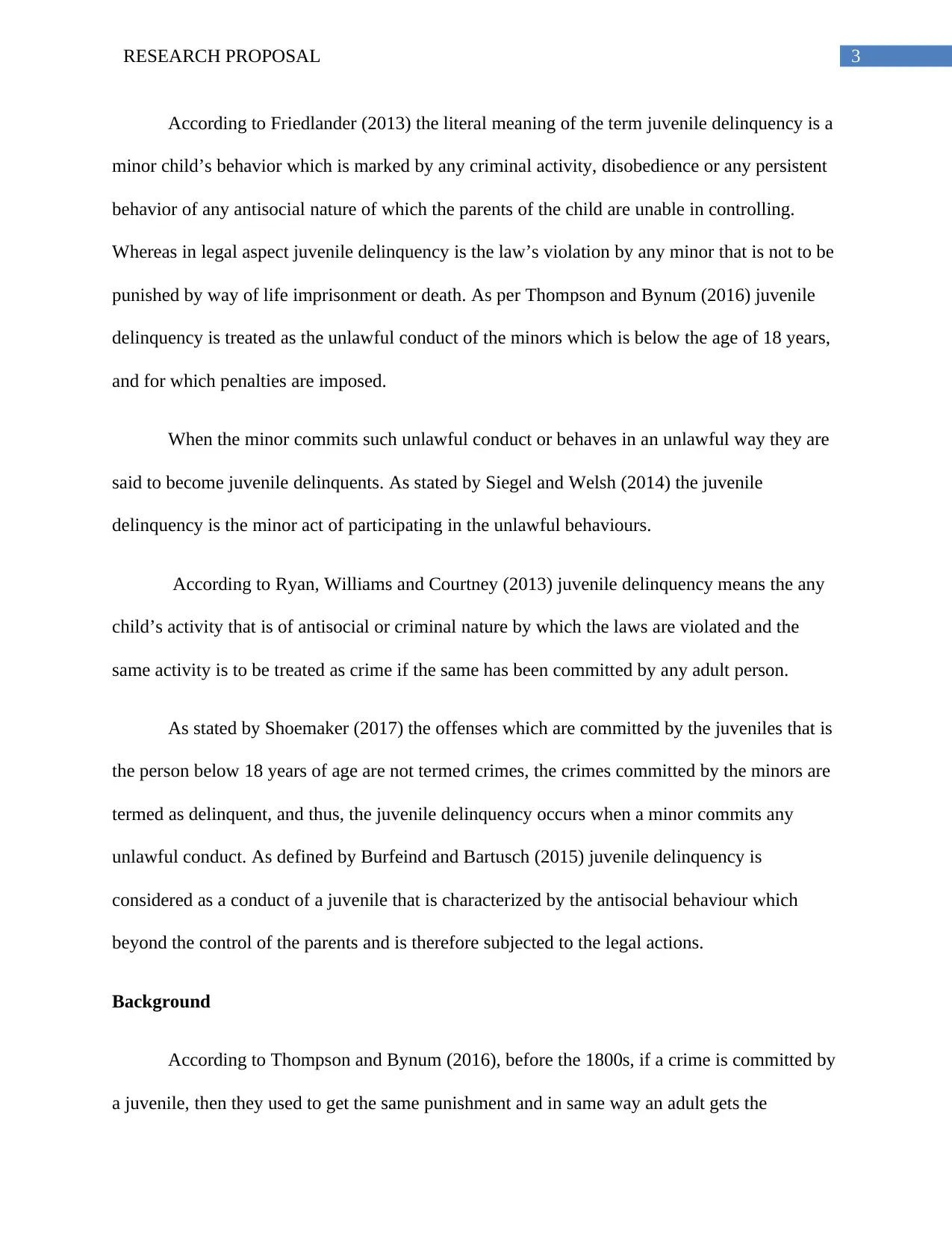
3RESEARCH PROPOSAL
According to Friedlander (2013) the literal meaning of the term juvenile delinquency is a
minor child’s behavior which is marked by any criminal activity, disobedience or any persistent
behavior of any antisocial nature of which the parents of the child are unable in controlling.
Whereas in legal aspect juvenile delinquency is the law’s violation by any minor that is not to be
punished by way of life imprisonment or death. As per Thompson and Bynum (2016) juvenile
delinquency is treated as the unlawful conduct of the minors which is below the age of 18 years,
and for which penalties are imposed.
When the minor commits such unlawful conduct or behaves in an unlawful way they are
said to become juvenile delinquents. As stated by Siegel and Welsh (2014) the juvenile
delinquency is the minor act of participating in the unlawful behaviours.
According to Ryan, Williams and Courtney (2013) juvenile delinquency means the any
child’s activity that is of antisocial or criminal nature by which the laws are violated and the
same activity is to be treated as crime if the same has been committed by any adult person.
As stated by Shoemaker (2017) the offenses which are committed by the juveniles that is
the person below 18 years of age are not termed crimes, the crimes committed by the minors are
termed as delinquent, and thus, the juvenile delinquency occurs when a minor commits any
unlawful conduct. As defined by Burfeind and Bartusch (2015) juvenile delinquency is
considered as a conduct of a juvenile that is characterized by the antisocial behaviour which
beyond the control of the parents and is therefore subjected to the legal actions.
Background
According to Thompson and Bynum (2016), before the 1800s, if a crime is committed by
a juvenile, then they used to get the same punishment and in same way an adult gets the
According to Friedlander (2013) the literal meaning of the term juvenile delinquency is a
minor child’s behavior which is marked by any criminal activity, disobedience or any persistent
behavior of any antisocial nature of which the parents of the child are unable in controlling.
Whereas in legal aspect juvenile delinquency is the law’s violation by any minor that is not to be
punished by way of life imprisonment or death. As per Thompson and Bynum (2016) juvenile
delinquency is treated as the unlawful conduct of the minors which is below the age of 18 years,
and for which penalties are imposed.
When the minor commits such unlawful conduct or behaves in an unlawful way they are
said to become juvenile delinquents. As stated by Siegel and Welsh (2014) the juvenile
delinquency is the minor act of participating in the unlawful behaviours.
According to Ryan, Williams and Courtney (2013) juvenile delinquency means the any
child’s activity that is of antisocial or criminal nature by which the laws are violated and the
same activity is to be treated as crime if the same has been committed by any adult person.
As stated by Shoemaker (2017) the offenses which are committed by the juveniles that is
the person below 18 years of age are not termed crimes, the crimes committed by the minors are
termed as delinquent, and thus, the juvenile delinquency occurs when a minor commits any
unlawful conduct. As defined by Burfeind and Bartusch (2015) juvenile delinquency is
considered as a conduct of a juvenile that is characterized by the antisocial behaviour which
beyond the control of the parents and is therefore subjected to the legal actions.
Background
According to Thompson and Bynum (2016), before the 1800s, if a crime is committed by
a juvenile, then they used to get the same punishment and in same way an adult gets the
Secure Best Marks with AI Grader
Need help grading? Try our AI Grader for instant feedback on your assignments.
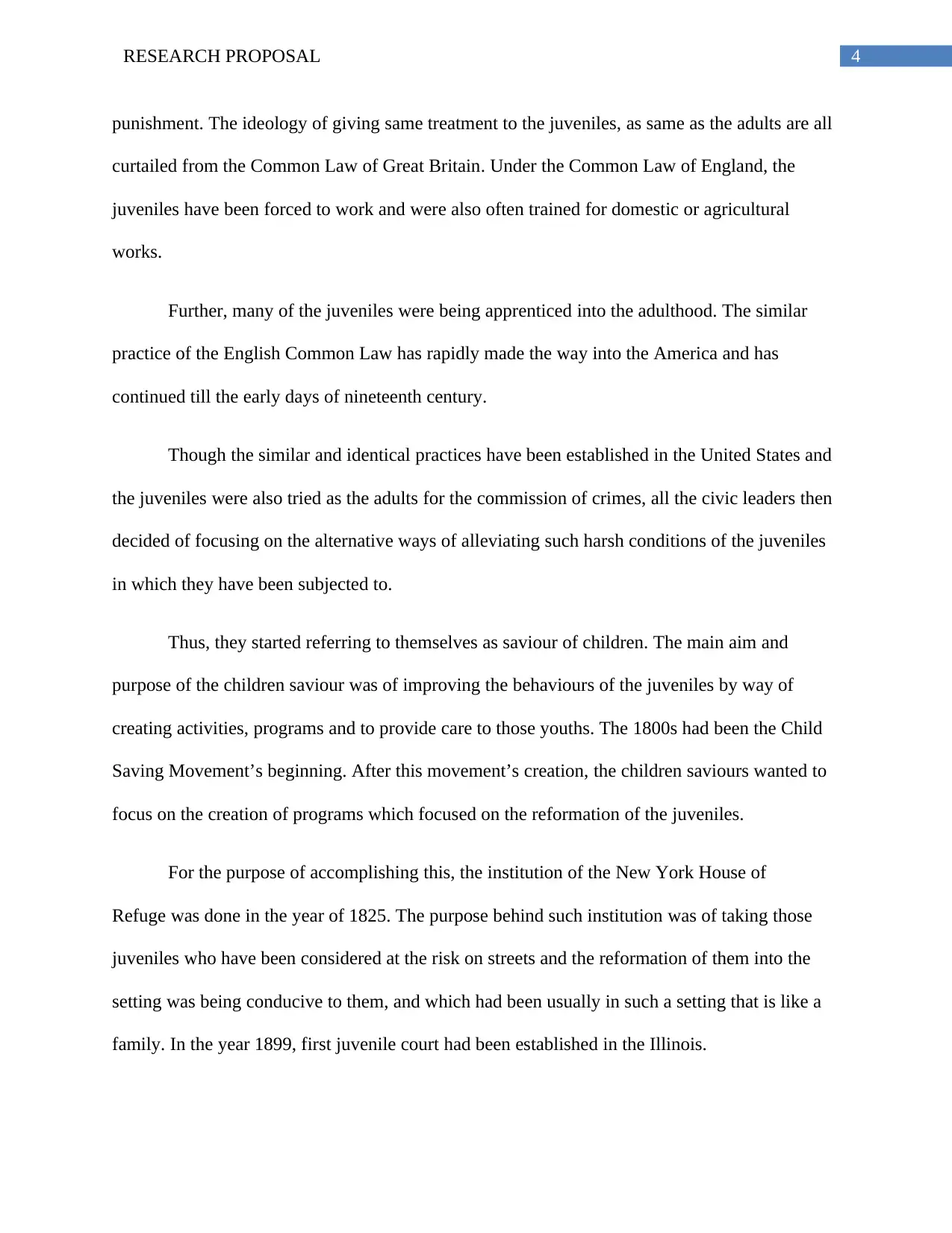
4RESEARCH PROPOSAL
punishment. The ideology of giving same treatment to the juveniles, as same as the adults are all
curtailed from the Common Law of Great Britain. Under the Common Law of England, the
juveniles have been forced to work and were also often trained for domestic or agricultural
works.
Further, many of the juveniles were being apprenticed into the adulthood. The similar
practice of the English Common Law has rapidly made the way into the America and has
continued till the early days of nineteenth century.
Though the similar and identical practices have been established in the United States and
the juveniles were also tried as the adults for the commission of crimes, all the civic leaders then
decided of focusing on the alternative ways of alleviating such harsh conditions of the juveniles
in which they have been subjected to.
Thus, they started referring to themselves as saviour of children. The main aim and
purpose of the children saviour was of improving the behaviours of the juveniles by way of
creating activities, programs and to provide care to those youths. The 1800s had been the Child
Saving Movement’s beginning. After this movement’s creation, the children saviours wanted to
focus on the creation of programs which focused on the reformation of the juveniles.
For the purpose of accomplishing this, the institution of the New York House of
Refuge was done in the year of 1825. The purpose behind such institution was of taking those
juveniles who have been considered at the risk on streets and the reformation of them into the
setting was being conducive to them, and which had been usually in such a setting that is like a
family. In the year 1899, first juvenile court had been established in the Illinois.
punishment. The ideology of giving same treatment to the juveniles, as same as the adults are all
curtailed from the Common Law of Great Britain. Under the Common Law of England, the
juveniles have been forced to work and were also often trained for domestic or agricultural
works.
Further, many of the juveniles were being apprenticed into the adulthood. The similar
practice of the English Common Law has rapidly made the way into the America and has
continued till the early days of nineteenth century.
Though the similar and identical practices have been established in the United States and
the juveniles were also tried as the adults for the commission of crimes, all the civic leaders then
decided of focusing on the alternative ways of alleviating such harsh conditions of the juveniles
in which they have been subjected to.
Thus, they started referring to themselves as saviour of children. The main aim and
purpose of the children saviour was of improving the behaviours of the juveniles by way of
creating activities, programs and to provide care to those youths. The 1800s had been the Child
Saving Movement’s beginning. After this movement’s creation, the children saviours wanted to
focus on the creation of programs which focused on the reformation of the juveniles.
For the purpose of accomplishing this, the institution of the New York House of
Refuge was done in the year of 1825. The purpose behind such institution was of taking those
juveniles who have been considered at the risk on streets and the reformation of them into the
setting was being conducive to them, and which had been usually in such a setting that is like a
family. In the year 1899, first juvenile court had been established in the Illinois.
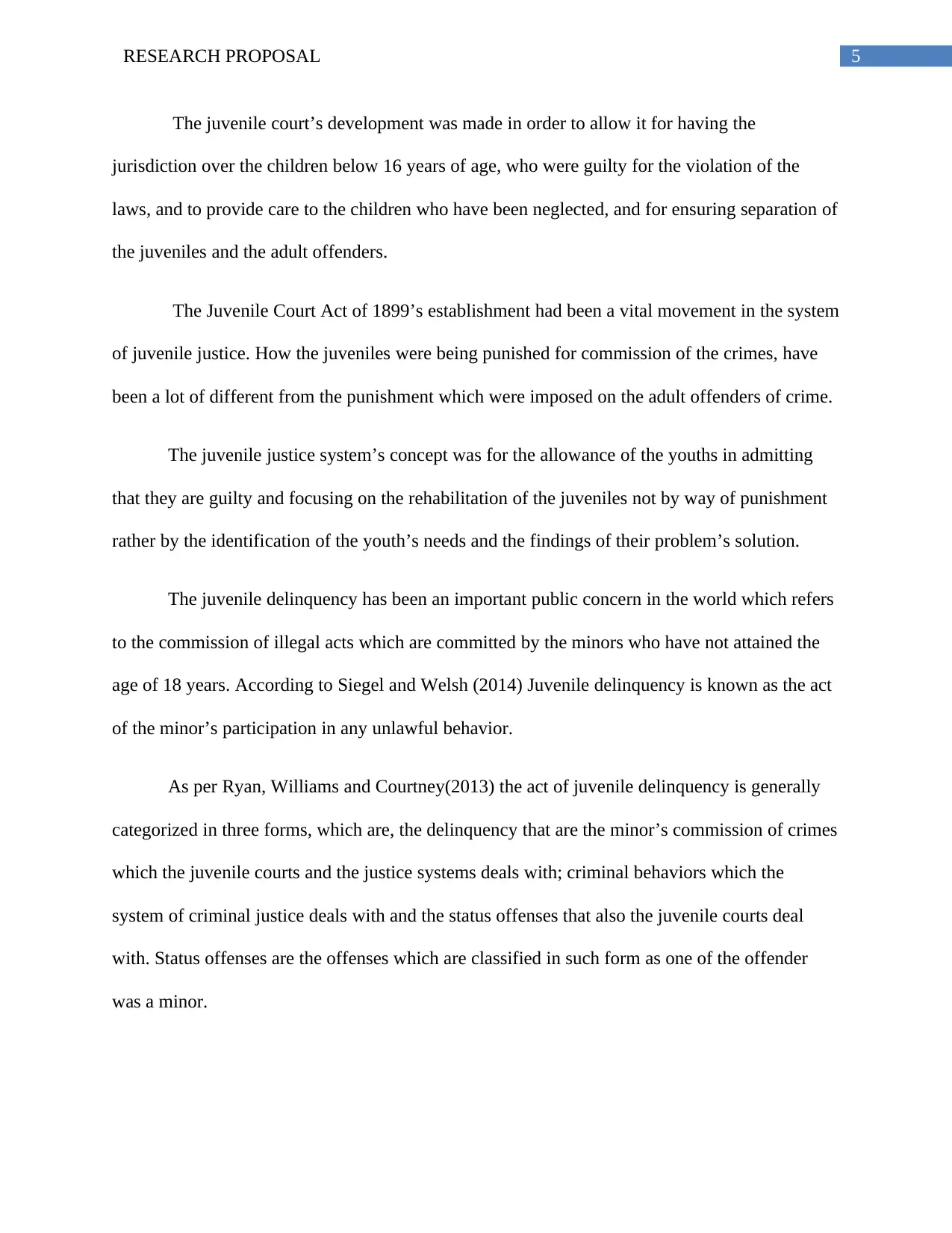
5RESEARCH PROPOSAL
The juvenile court’s development was made in order to allow it for having the
jurisdiction over the children below 16 years of age, who were guilty for the violation of the
laws, and to provide care to the children who have been neglected, and for ensuring separation of
the juveniles and the adult offenders.
The Juvenile Court Act of 1899’s establishment had been a vital movement in the system
of juvenile justice. How the juveniles were being punished for commission of the crimes, have
been a lot of different from the punishment which were imposed on the adult offenders of crime.
The juvenile justice system’s concept was for the allowance of the youths in admitting
that they are guilty and focusing on the rehabilitation of the juveniles not by way of punishment
rather by the identification of the youth’s needs and the findings of their problem’s solution.
The juvenile delinquency has been an important public concern in the world which refers
to the commission of illegal acts which are committed by the minors who have not attained the
age of 18 years. According to Siegel and Welsh (2014) Juvenile delinquency is known as the act
of the minor’s participation in any unlawful behavior.
As per Ryan, Williams and Courtney(2013) the act of juvenile delinquency is generally
categorized in three forms, which are, the delinquency that are the minor’s commission of crimes
which the juvenile courts and the justice systems deals with; criminal behaviors which the
system of criminal justice deals with and the status offenses that also the juvenile courts deal
with. Status offenses are the offenses which are classified in such form as one of the offender
was a minor.
The juvenile court’s development was made in order to allow it for having the
jurisdiction over the children below 16 years of age, who were guilty for the violation of the
laws, and to provide care to the children who have been neglected, and for ensuring separation of
the juveniles and the adult offenders.
The Juvenile Court Act of 1899’s establishment had been a vital movement in the system
of juvenile justice. How the juveniles were being punished for commission of the crimes, have
been a lot of different from the punishment which were imposed on the adult offenders of crime.
The juvenile justice system’s concept was for the allowance of the youths in admitting
that they are guilty and focusing on the rehabilitation of the juveniles not by way of punishment
rather by the identification of the youth’s needs and the findings of their problem’s solution.
The juvenile delinquency has been an important public concern in the world which refers
to the commission of illegal acts which are committed by the minors who have not attained the
age of 18 years. According to Siegel and Welsh (2014) Juvenile delinquency is known as the act
of the minor’s participation in any unlawful behavior.
As per Ryan, Williams and Courtney(2013) the act of juvenile delinquency is generally
categorized in three forms, which are, the delinquency that are the minor’s commission of crimes
which the juvenile courts and the justice systems deals with; criminal behaviors which the
system of criminal justice deals with and the status offenses that also the juvenile courts deal
with. Status offenses are the offenses which are classified in such form as one of the offender
was a minor.
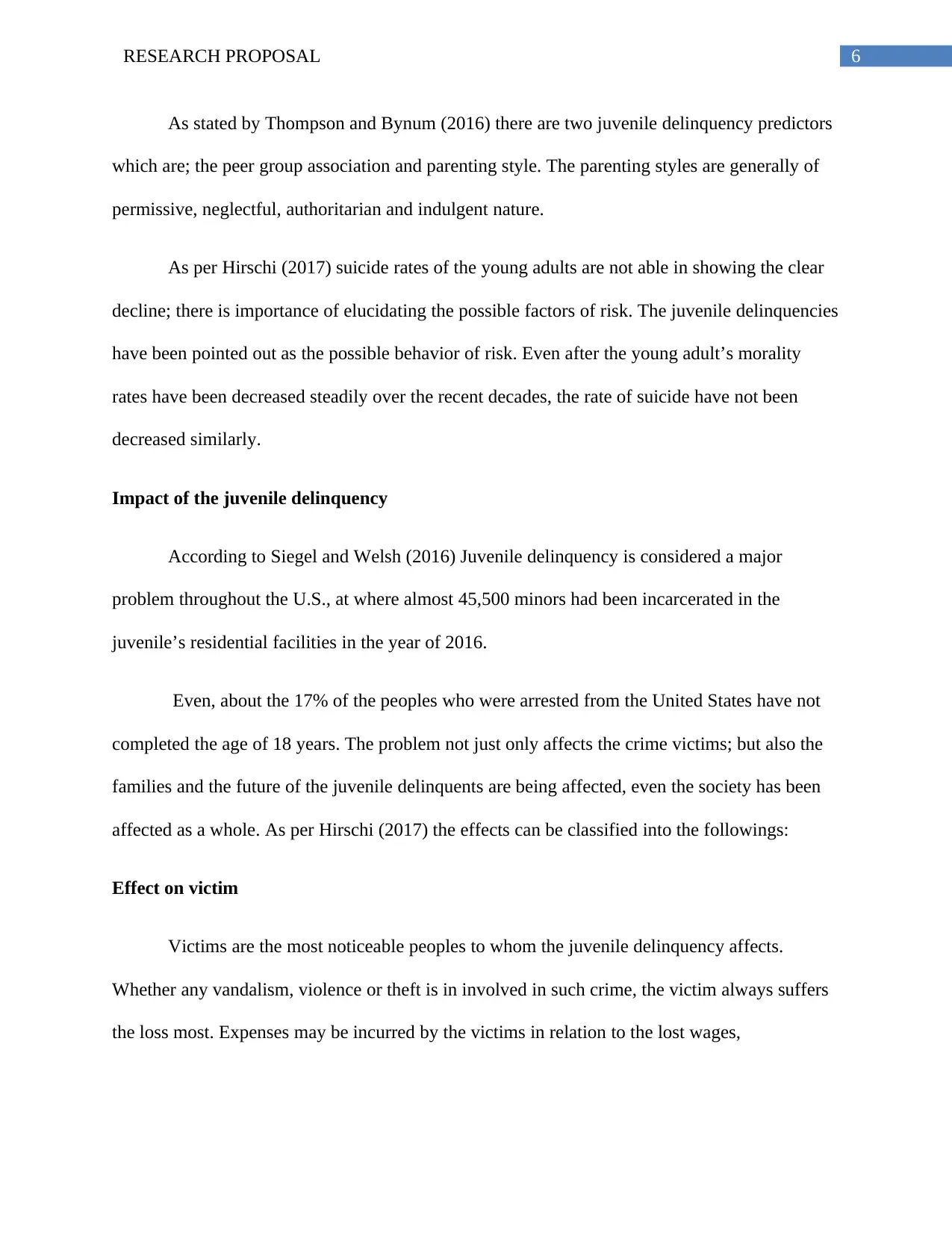
6RESEARCH PROPOSAL
As stated by Thompson and Bynum (2016) there are two juvenile delinquency predictors
which are; the peer group association and parenting style. The parenting styles are generally of
permissive, neglectful, authoritarian and indulgent nature.
As per Hirschi (2017) suicide rates of the young adults are not able in showing the clear
decline; there is importance of elucidating the possible factors of risk. The juvenile delinquencies
have been pointed out as the possible behavior of risk. Even after the young adult’s morality
rates have been decreased steadily over the recent decades, the rate of suicide have not been
decreased similarly.
Impact of the juvenile delinquency
According to Siegel and Welsh (2016) Juvenile delinquency is considered a major
problem throughout the U.S., at where almost 45,500 minors had been incarcerated in the
juvenile’s residential facilities in the year of 2016.
Even, about the 17% of the peoples who were arrested from the United States have not
completed the age of 18 years. The problem not just only affects the crime victims; but also the
families and the future of the juvenile delinquents are being affected, even the society has been
affected as a whole. As per Hirschi (2017) the effects can be classified into the followings:
Effect on victim
Victims are the most noticeable peoples to whom the juvenile delinquency affects.
Whether any vandalism, violence or theft is in involved in such crime, the victim always suffers
the loss most. Expenses may be incurred by the victims in relation to the lost wages,
As stated by Thompson and Bynum (2016) there are two juvenile delinquency predictors
which are; the peer group association and parenting style. The parenting styles are generally of
permissive, neglectful, authoritarian and indulgent nature.
As per Hirschi (2017) suicide rates of the young adults are not able in showing the clear
decline; there is importance of elucidating the possible factors of risk. The juvenile delinquencies
have been pointed out as the possible behavior of risk. Even after the young adult’s morality
rates have been decreased steadily over the recent decades, the rate of suicide have not been
decreased similarly.
Impact of the juvenile delinquency
According to Siegel and Welsh (2016) Juvenile delinquency is considered a major
problem throughout the U.S., at where almost 45,500 minors had been incarcerated in the
juvenile’s residential facilities in the year of 2016.
Even, about the 17% of the peoples who were arrested from the United States have not
completed the age of 18 years. The problem not just only affects the crime victims; but also the
families and the future of the juvenile delinquents are being affected, even the society has been
affected as a whole. As per Hirschi (2017) the effects can be classified into the followings:
Effect on victim
Victims are the most noticeable peoples to whom the juvenile delinquency affects.
Whether any vandalism, violence or theft is in involved in such crime, the victim always suffers
the loss most. Expenses may be incurred by the victims in relation to the lost wages,
Paraphrase This Document
Need a fresh take? Get an instant paraphrase of this document with our AI Paraphraser
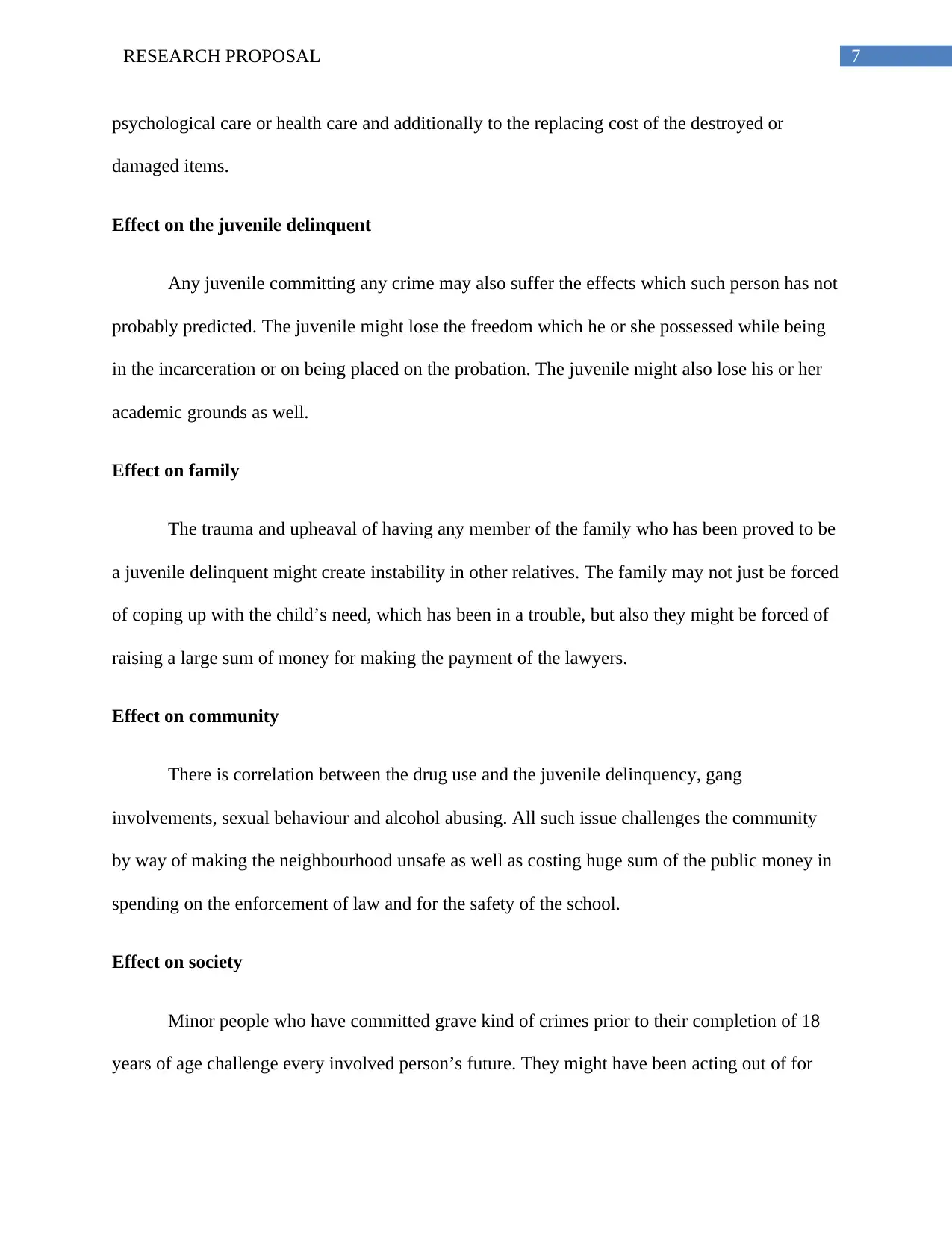
7RESEARCH PROPOSAL
psychological care or health care and additionally to the replacing cost of the destroyed or
damaged items.
Effect on the juvenile delinquent
Any juvenile committing any crime may also suffer the effects which such person has not
probably predicted. The juvenile might lose the freedom which he or she possessed while being
in the incarceration or on being placed on the probation. The juvenile might also lose his or her
academic grounds as well.
Effect on family
The trauma and upheaval of having any member of the family who has been proved to be
a juvenile delinquent might create instability in other relatives. The family may not just be forced
of coping up with the child’s need, which has been in a trouble, but also they might be forced of
raising a large sum of money for making the payment of the lawyers.
Effect on community
There is correlation between the drug use and the juvenile delinquency, gang
involvements, sexual behaviour and alcohol abusing. All such issue challenges the community
by way of making the neighbourhood unsafe as well as costing huge sum of the public money in
spending on the enforcement of law and for the safety of the school.
Effect on society
Minor people who have committed grave kind of crimes prior to their completion of 18
years of age challenge every involved person’s future. They might have been acting out of for
psychological care or health care and additionally to the replacing cost of the destroyed or
damaged items.
Effect on the juvenile delinquent
Any juvenile committing any crime may also suffer the effects which such person has not
probably predicted. The juvenile might lose the freedom which he or she possessed while being
in the incarceration or on being placed on the probation. The juvenile might also lose his or her
academic grounds as well.
Effect on family
The trauma and upheaval of having any member of the family who has been proved to be
a juvenile delinquent might create instability in other relatives. The family may not just be forced
of coping up with the child’s need, which has been in a trouble, but also they might be forced of
raising a large sum of money for making the payment of the lawyers.
Effect on community
There is correlation between the drug use and the juvenile delinquency, gang
involvements, sexual behaviour and alcohol abusing. All such issue challenges the community
by way of making the neighbourhood unsafe as well as costing huge sum of the public money in
spending on the enforcement of law and for the safety of the school.
Effect on society
Minor people who have committed grave kind of crimes prior to their completion of 18
years of age challenge every involved person’s future. They might have been acting out of for

8RESEARCH PROPOSAL
protesting the abuses of perceives nature, which had been committed against such minors. They
might believe they have no future beyond the crime life.
They might have been expressing their anger or the frustration against any other person
or against any other group or might be seeking the approval of any gang. Whichever be the
motive, the juvenile delinquency do affect numerous individuals, communities and families.
The Gap
According to Siegel and Welsh (2016), juvenile delinquency is considered as a major
problem in whole world particularly in the United States. It is to be considered as the most
serious kind of problems in the society.
The juvenile delinquency has been an important public concern in the world which refers
to the commission of illegal acts which are committed by the minors who have not attained the
age of 18 years. The juvenile delinquency and bad behavior is a product of the modern
industrialization and urbanization.
Two juvenile delinquency predictors are there which are; the style of parenting and the
peer group association. The style of parenting is generally of the permissive, neglectful,
authoritarian and indulgent nature. A great number of attentions are required for the problem as
various affects and causes are involved in it.
17% of the arrested United States citizens are below 18 years of age thus, juvenile
delinquency is a serious threat to the society. It has a great effect on the victims as well as on the
offender’s future, their family and to the society.
protesting the abuses of perceives nature, which had been committed against such minors. They
might believe they have no future beyond the crime life.
They might have been expressing their anger or the frustration against any other person
or against any other group or might be seeking the approval of any gang. Whichever be the
motive, the juvenile delinquency do affect numerous individuals, communities and families.
The Gap
According to Siegel and Welsh (2016), juvenile delinquency is considered as a major
problem in whole world particularly in the United States. It is to be considered as the most
serious kind of problems in the society.
The juvenile delinquency has been an important public concern in the world which refers
to the commission of illegal acts which are committed by the minors who have not attained the
age of 18 years. The juvenile delinquency and bad behavior is a product of the modern
industrialization and urbanization.
Two juvenile delinquency predictors are there which are; the style of parenting and the
peer group association. The style of parenting is generally of the permissive, neglectful,
authoritarian and indulgent nature. A great number of attentions are required for the problem as
various affects and causes are involved in it.
17% of the arrested United States citizens are below 18 years of age thus, juvenile
delinquency is a serious threat to the society. It has a great effect on the victims as well as on the
offender’s future, their family and to the society.

9RESEARCH PROPOSAL
Hypotheses
H1- Juvenile delinquency and Bad behavior has an impact on victims, juvenile delinquents,
family, community and the society
H0 - Juvenile delinquency and Bad behavior has no impact on the victims, juvenile delinquents,
family, community and the society
Research aim and objective
The aim of this research is to investigate and identify the issue of Juvenile delinquency
and Bad behavior. Following are the key objectives to meet the states aim.
To identify the impact Juvenile delinquency and Bad behavior on the victim and the
society
To critically identify the factors causing the bad behavior and juvenile delinquency in
youths.
To identify the suitable methods of preventing the bad behavior and juvenile delinquency
The research proposal structure
The research proposal structure would include the following chapterization:
The first chapter introduction chapter refers the research study’s introductory chapter,
hypotheses, statement of the problem, research aim and objectives, which will be described by
the researcher. The second chapter will describe the models and theories along with the selected
topic’s concept. The research methodology will be demonstrated in the third chapter. This
chapter would describe the method of data collection, the method of data analysis and the data
collection result.
Hypotheses
H1- Juvenile delinquency and Bad behavior has an impact on victims, juvenile delinquents,
family, community and the society
H0 - Juvenile delinquency and Bad behavior has no impact on the victims, juvenile delinquents,
family, community and the society
Research aim and objective
The aim of this research is to investigate and identify the issue of Juvenile delinquency
and Bad behavior. Following are the key objectives to meet the states aim.
To identify the impact Juvenile delinquency and Bad behavior on the victim and the
society
To critically identify the factors causing the bad behavior and juvenile delinquency in
youths.
To identify the suitable methods of preventing the bad behavior and juvenile delinquency
The research proposal structure
The research proposal structure would include the following chapterization:
The first chapter introduction chapter refers the research study’s introductory chapter,
hypotheses, statement of the problem, research aim and objectives, which will be described by
the researcher. The second chapter will describe the models and theories along with the selected
topic’s concept. The research methodology will be demonstrated in the third chapter. This
chapter would describe the method of data collection, the method of data analysis and the data
collection result.
Secure Best Marks with AI Grader
Need help grading? Try our AI Grader for instant feedback on your assignments.

10RESEARCH PROPOSAL
Methodology
Introduction
Qualitative study research is the chosen methodology for this paper. For serving the
purpose of collecting data, the research would be making use of the qualitative study research
method or the secondary research method by way of which the researcher would be presenting
legislative provisions, scholarly articles, and books for the purpose of relevant information.
Additionally, for the purpose of interpreting and analyzing the data which is to be collected, the
researcher would be taking help of the qualitative study research method for the purpose of
investigating and identifying the issues and impacts of the juvenile delinquency and bad
behavior.
The Independent Variable for the research project is juvenile delinquency and bad
behavior and the dependent variables for the research project are victims, juvenile delinquents,
family, community and the society. The researcher plans to measure the variables through the
use of Graphs and tables. The researcher will also carry out a survey through 50 respondents
which would be randomly chosen across a specific population. All data collected by the
researcher will be kept confidential to ensure that no privacy provisions are violated. The
researcher will also collect secondary data for the researcher project and ensure that proper
referencing and citations have been done to avoid any intellectual property rights issues.
Expected outcome
After the collection of the relevant data and after analyzing the same, the research
supports the fact that it is necessary to prevent the bad behavior and juvenile delinquency in
Methodology
Introduction
Qualitative study research is the chosen methodology for this paper. For serving the
purpose of collecting data, the research would be making use of the qualitative study research
method or the secondary research method by way of which the researcher would be presenting
legislative provisions, scholarly articles, and books for the purpose of relevant information.
Additionally, for the purpose of interpreting and analyzing the data which is to be collected, the
researcher would be taking help of the qualitative study research method for the purpose of
investigating and identifying the issues and impacts of the juvenile delinquency and bad
behavior.
The Independent Variable for the research project is juvenile delinquency and bad
behavior and the dependent variables for the research project are victims, juvenile delinquents,
family, community and the society. The researcher plans to measure the variables through the
use of Graphs and tables. The researcher will also carry out a survey through 50 respondents
which would be randomly chosen across a specific population. All data collected by the
researcher will be kept confidential to ensure that no privacy provisions are violated. The
researcher will also collect secondary data for the researcher project and ensure that proper
referencing and citations have been done to avoid any intellectual property rights issues.
Expected outcome
After the collection of the relevant data and after analyzing the same, the research
supports the fact that it is necessary to prevent the bad behavior and juvenile delinquency in

11RESEARCH PROPOSAL
today world for the purpose of decreasing the crime rates, suicide rates among the youth, drug
abuse, alcohol abuse as well as for securing the public policy and the betterment of the
community and the society as a whole. Juvenile delinquency has now become a major worldwide
problem which is suffered by the victims, juvenile delinquent themselves, their families,
communities and even by the society. In order to reach that purpose several new legislation are
to be enacted and the older laws need to be amended and general awareness must be made within
the public.
today world for the purpose of decreasing the crime rates, suicide rates among the youth, drug
abuse, alcohol abuse as well as for securing the public policy and the betterment of the
community and the society as a whole. Juvenile delinquency has now become a major worldwide
problem which is suffered by the victims, juvenile delinquent themselves, their families,
communities and even by the society. In order to reach that purpose several new legislation are
to be enacted and the older laws need to be amended and general awareness must be made within
the public.
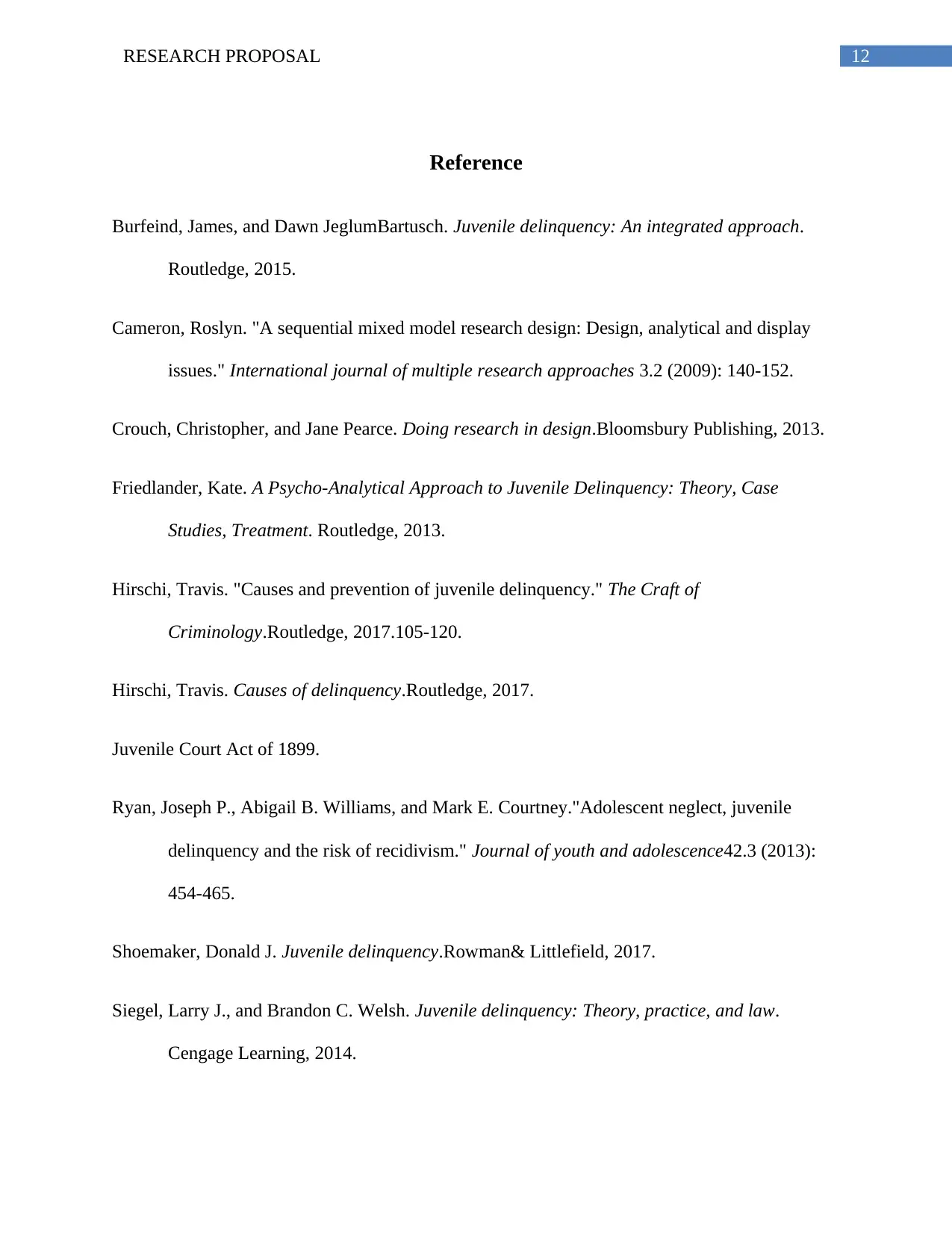
12RESEARCH PROPOSAL
Reference
Burfeind, James, and Dawn JeglumBartusch. Juvenile delinquency: An integrated approach.
Routledge, 2015.
Cameron, Roslyn. "A sequential mixed model research design: Design, analytical and display
issues." International journal of multiple research approaches 3.2 (2009): 140-152.
Crouch, Christopher, and Jane Pearce. Doing research in design.Bloomsbury Publishing, 2013.
Friedlander, Kate. A Psycho-Analytical Approach to Juvenile Delinquency: Theory, Case
Studies, Treatment. Routledge, 2013.
Hirschi, Travis. "Causes and prevention of juvenile delinquency." The Craft of
Criminology.Routledge, 2017.105-120.
Hirschi, Travis. Causes of delinquency.Routledge, 2017.
Juvenile Court Act of 1899.
Ryan, Joseph P., Abigail B. Williams, and Mark E. Courtney."Adolescent neglect, juvenile
delinquency and the risk of recidivism." Journal of youth and adolescence42.3 (2013):
454-465.
Shoemaker, Donald J. Juvenile delinquency.Rowman& Littlefield, 2017.
Siegel, Larry J., and Brandon C. Welsh. Juvenile delinquency: Theory, practice, and law.
Cengage Learning, 2014.
Reference
Burfeind, James, and Dawn JeglumBartusch. Juvenile delinquency: An integrated approach.
Routledge, 2015.
Cameron, Roslyn. "A sequential mixed model research design: Design, analytical and display
issues." International journal of multiple research approaches 3.2 (2009): 140-152.
Crouch, Christopher, and Jane Pearce. Doing research in design.Bloomsbury Publishing, 2013.
Friedlander, Kate. A Psycho-Analytical Approach to Juvenile Delinquency: Theory, Case
Studies, Treatment. Routledge, 2013.
Hirschi, Travis. "Causes and prevention of juvenile delinquency." The Craft of
Criminology.Routledge, 2017.105-120.
Hirschi, Travis. Causes of delinquency.Routledge, 2017.
Juvenile Court Act of 1899.
Ryan, Joseph P., Abigail B. Williams, and Mark E. Courtney."Adolescent neglect, juvenile
delinquency and the risk of recidivism." Journal of youth and adolescence42.3 (2013):
454-465.
Shoemaker, Donald J. Juvenile delinquency.Rowman& Littlefield, 2017.
Siegel, Larry J., and Brandon C. Welsh. Juvenile delinquency: Theory, practice, and law.
Cengage Learning, 2014.
Paraphrase This Document
Need a fresh take? Get an instant paraphrase of this document with our AI Paraphraser
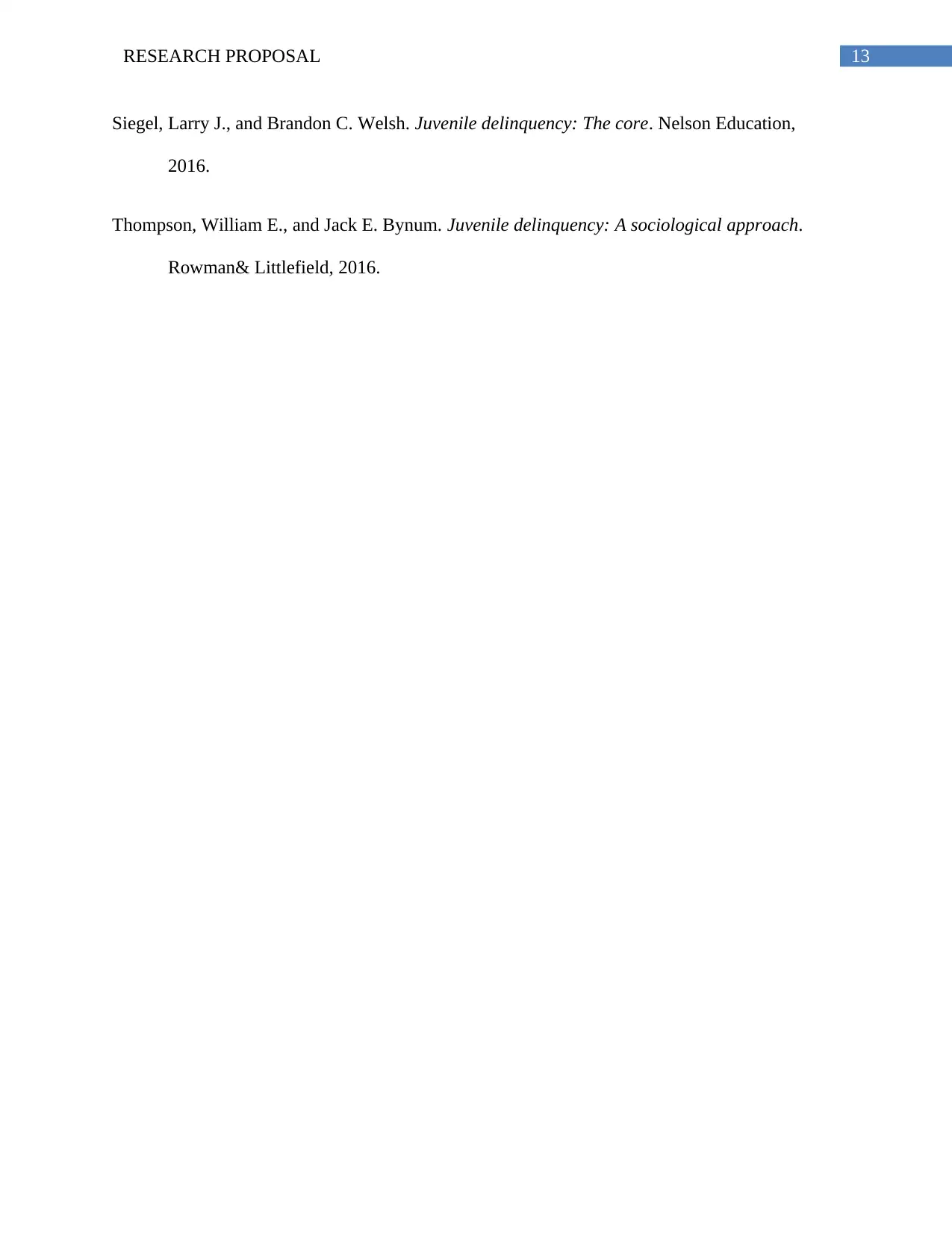
13RESEARCH PROPOSAL
Siegel, Larry J., and Brandon C. Welsh. Juvenile delinquency: The core. Nelson Education,
2016.
Thompson, William E., and Jack E. Bynum. Juvenile delinquency: A sociological approach.
Rowman& Littlefield, 2016.
Siegel, Larry J., and Brandon C. Welsh. Juvenile delinquency: The core. Nelson Education,
2016.
Thompson, William E., and Jack E. Bynum. Juvenile delinquency: A sociological approach.
Rowman& Littlefield, 2016.
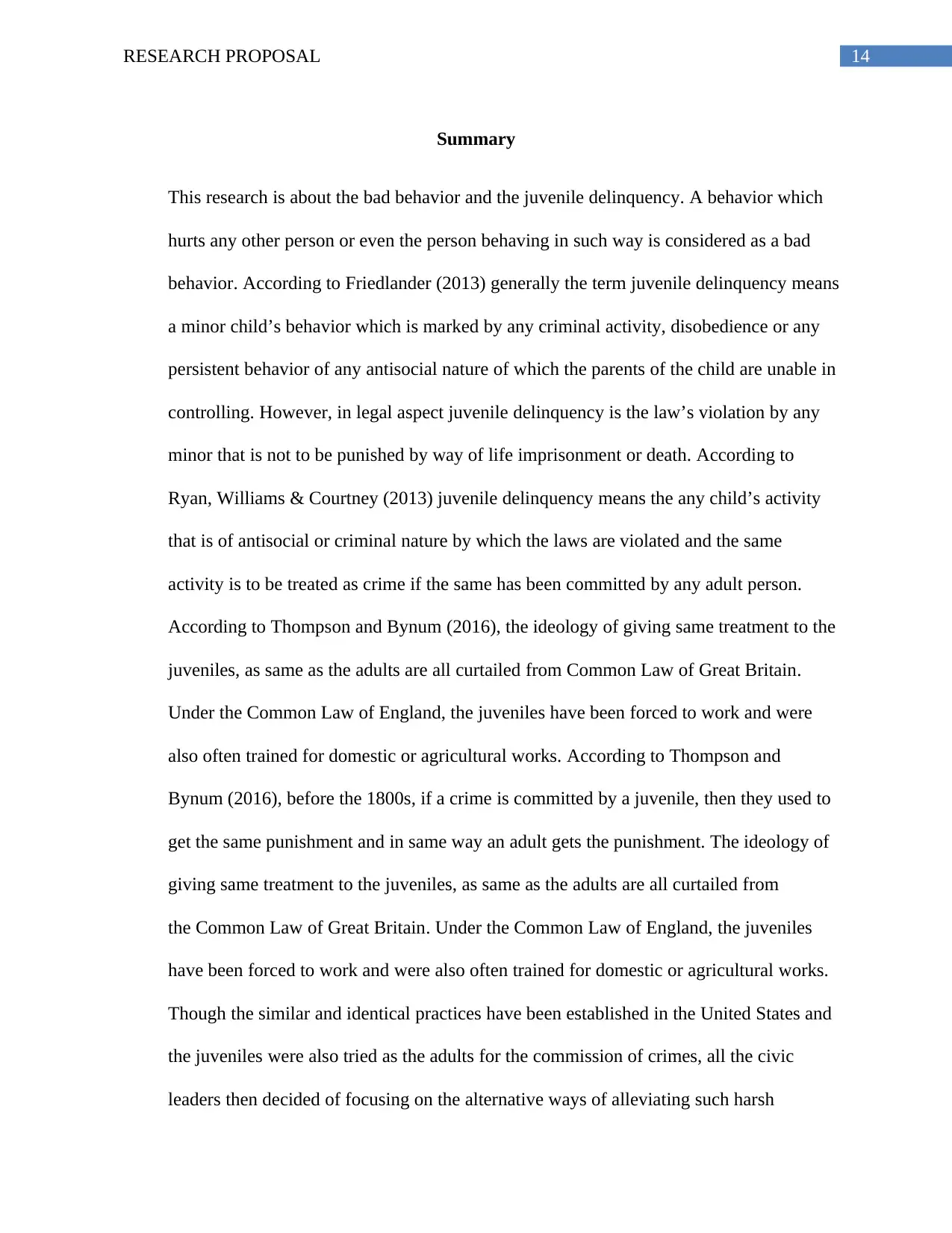
14RESEARCH PROPOSAL
Summary
This research is about the bad behavior and the juvenile delinquency. A behavior which
hurts any other person or even the person behaving in such way is considered as a bad
behavior. According to Friedlander (2013) generally the term juvenile delinquency means
a minor child’s behavior which is marked by any criminal activity, disobedience or any
persistent behavior of any antisocial nature of which the parents of the child are unable in
controlling. However, in legal aspect juvenile delinquency is the law’s violation by any
minor that is not to be punished by way of life imprisonment or death. According to
Ryan, Williams & Courtney (2013) juvenile delinquency means the any child’s activity
that is of antisocial or criminal nature by which the laws are violated and the same
activity is to be treated as crime if the same has been committed by any adult person.
According to Thompson and Bynum (2016), the ideology of giving same treatment to the
juveniles, as same as the adults are all curtailed from Common Law of Great Britain.
Under the Common Law of England, the juveniles have been forced to work and were
also often trained for domestic or agricultural works. According to Thompson and
Bynum (2016), before the 1800s, if a crime is committed by a juvenile, then they used to
get the same punishment and in same way an adult gets the punishment. The ideology of
giving same treatment to the juveniles, as same as the adults are all curtailed from
the Common Law of Great Britain. Under the Common Law of England, the juveniles
have been forced to work and were also often trained for domestic or agricultural works.
Though the similar and identical practices have been established in the United States and
the juveniles were also tried as the adults for the commission of crimes, all the civic
leaders then decided of focusing on the alternative ways of alleviating such harsh
Summary
This research is about the bad behavior and the juvenile delinquency. A behavior which
hurts any other person or even the person behaving in such way is considered as a bad
behavior. According to Friedlander (2013) generally the term juvenile delinquency means
a minor child’s behavior which is marked by any criminal activity, disobedience or any
persistent behavior of any antisocial nature of which the parents of the child are unable in
controlling. However, in legal aspect juvenile delinquency is the law’s violation by any
minor that is not to be punished by way of life imprisonment or death. According to
Ryan, Williams & Courtney (2013) juvenile delinquency means the any child’s activity
that is of antisocial or criminal nature by which the laws are violated and the same
activity is to be treated as crime if the same has been committed by any adult person.
According to Thompson and Bynum (2016), the ideology of giving same treatment to the
juveniles, as same as the adults are all curtailed from Common Law of Great Britain.
Under the Common Law of England, the juveniles have been forced to work and were
also often trained for domestic or agricultural works. According to Thompson and
Bynum (2016), before the 1800s, if a crime is committed by a juvenile, then they used to
get the same punishment and in same way an adult gets the punishment. The ideology of
giving same treatment to the juveniles, as same as the adults are all curtailed from
the Common Law of Great Britain. Under the Common Law of England, the juveniles
have been forced to work and were also often trained for domestic or agricultural works.
Though the similar and identical practices have been established in the United States and
the juveniles were also tried as the adults for the commission of crimes, all the civic
leaders then decided of focusing on the alternative ways of alleviating such harsh
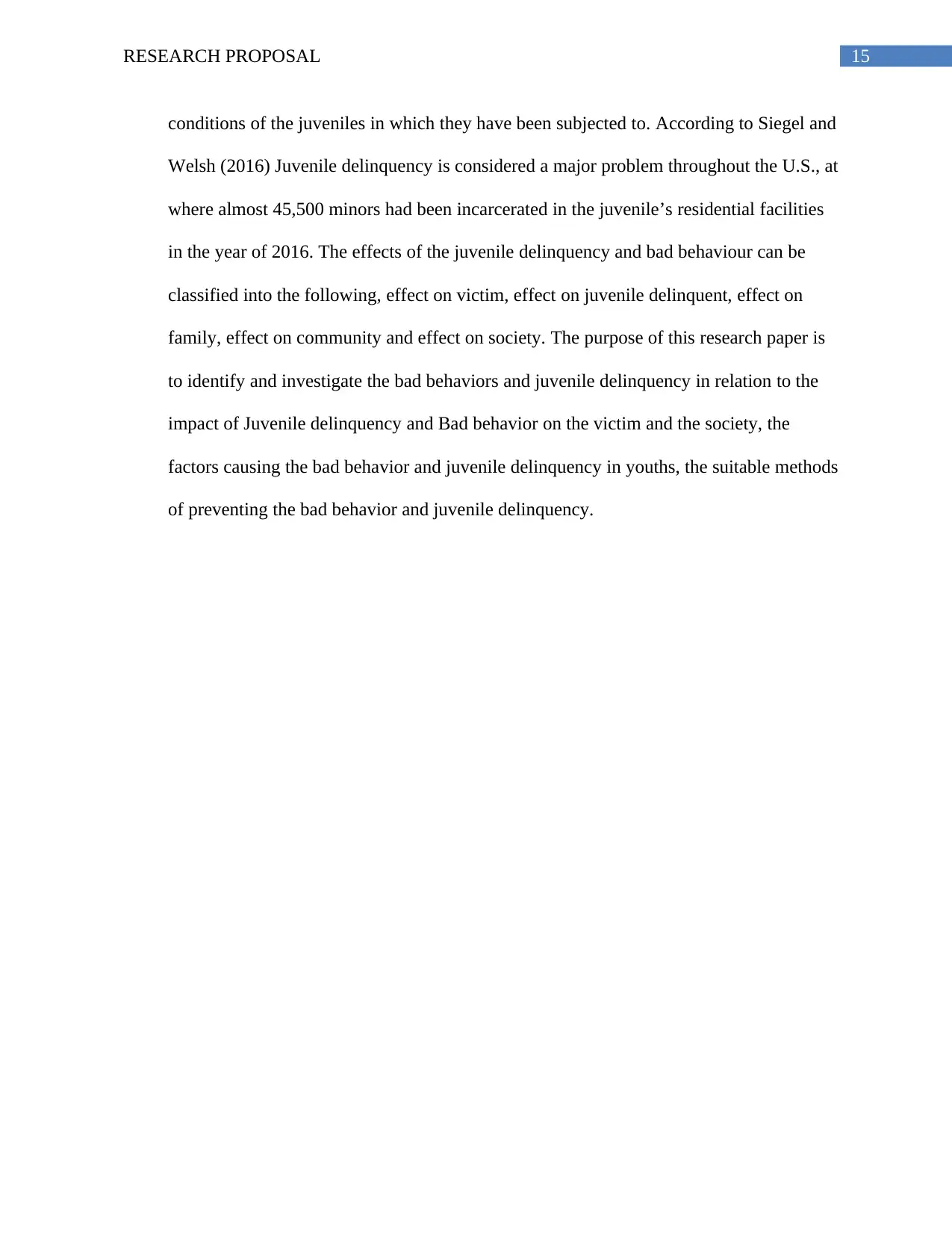
15RESEARCH PROPOSAL
conditions of the juveniles in which they have been subjected to. According to Siegel and
Welsh (2016) Juvenile delinquency is considered a major problem throughout the U.S., at
where almost 45,500 minors had been incarcerated in the juvenile’s residential facilities
in the year of 2016. The effects of the juvenile delinquency and bad behaviour can be
classified into the following, effect on victim, effect on juvenile delinquent, effect on
family, effect on community and effect on society. The purpose of this research paper is
to identify and investigate the bad behaviors and juvenile delinquency in relation to the
impact of Juvenile delinquency and Bad behavior on the victim and the society, the
factors causing the bad behavior and juvenile delinquency in youths, the suitable methods
of preventing the bad behavior and juvenile delinquency.
conditions of the juveniles in which they have been subjected to. According to Siegel and
Welsh (2016) Juvenile delinquency is considered a major problem throughout the U.S., at
where almost 45,500 minors had been incarcerated in the juvenile’s residential facilities
in the year of 2016. The effects of the juvenile delinquency and bad behaviour can be
classified into the following, effect on victim, effect on juvenile delinquent, effect on
family, effect on community and effect on society. The purpose of this research paper is
to identify and investigate the bad behaviors and juvenile delinquency in relation to the
impact of Juvenile delinquency and Bad behavior on the victim and the society, the
factors causing the bad behavior and juvenile delinquency in youths, the suitable methods
of preventing the bad behavior and juvenile delinquency.
1 out of 16
Related Documents
Your All-in-One AI-Powered Toolkit for Academic Success.
+13062052269
info@desklib.com
Available 24*7 on WhatsApp / Email
![[object Object]](/_next/static/media/star-bottom.7253800d.svg)
Unlock your academic potential
© 2024 | Zucol Services PVT LTD | All rights reserved.




